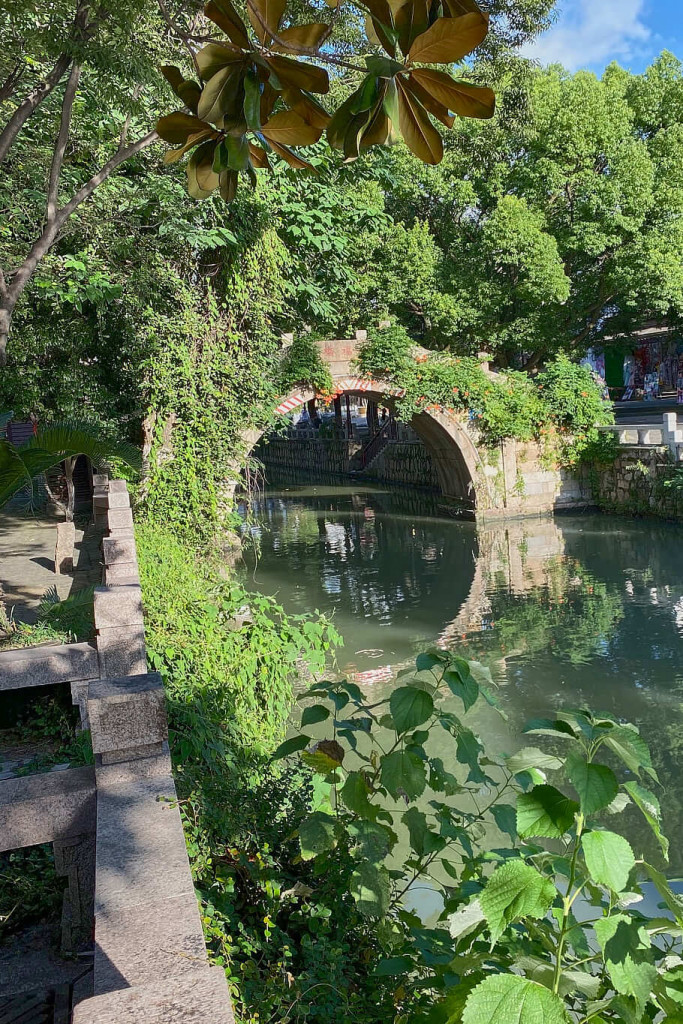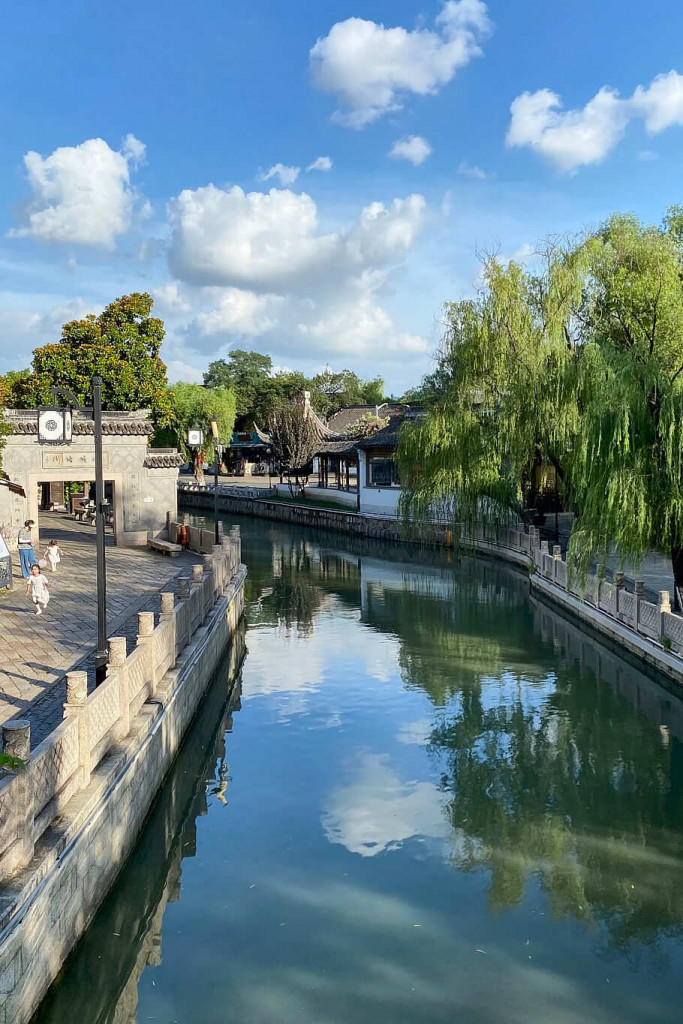During my time in China, I’ve always loved escaping to Wuxi (无锡) and Suzhou (苏州) for a relaxing weekend. Thanks to the convenient high-speed train system, it’s easy to reach these cities. What attracts me most is their deep cultural roots and stunning natural beauty. Unlike the lively pace of Shanghai, Wuxi and Suzhou offer a more laid-back atmosphere, perfect for unhurried exploration and leisurely strolls. The Wuxi and Suzhou Highlights described in this post are some of my favorites.
In the scorching summer, Wuxi’s proximity to Taihu Lake ensures a cooler climate, making it a welcoming retreat from the heat of Shanghai. Additionally, my recent trip to Suzhou led me to the charming Mudu Ancient Town, a place that I recently discovered and was drawn to its uniqueness as an ancient garden town.


Wuxi and Suzhou Highlights and Accommodation
I booked a night at the Wuxi Intercontinental Hotel, which offered a very reasonable room rate compared to some other hotels in major Chinese cities. The breakfast spread was impressive, featuring not only traditional Chinese and Japanese dishes but also a variety of European options. Moreover, its central location allowed easy access to the renowned Nanchangjie and convenient proximity to the train station.
Day 1: Yuantouyhu (鼋头渚) and Nanchang Jie (南长街) (Wuxi)
- Start my journey by taking a high-speed train from Shanghai to Wuxi Central Station.
- From Wuxi Central Station, hop on local Bus No.1 to Yuantouzhu.
- Enjoy a quick and tasty lunch within the park.
- In the afternoon, check-in at the luxurious Wuxi Intercontinental Hotel.
- As the sun set, I ventured to Nanchang Jie a bustling street known for shopping, local delicacies, and night scenes.
Day 2: Huishan Ancient Town (惠山古镇) (Wuxi) and Mudu,Ancient Town (木渎古镇) (Suzhou)
- After check-out, headed to Huishan Ancient Town.
- Caught a high-speed train to Suzhou. From Suzhou Train Station, I took Bus No.38 and got off at the bus stop GuZhenCuiFangQiao (古镇翠坊桥), walked approximately 370 metres to Mudu Ancient Town.
- Took a high-speed train ride back to the vibrant city of Shanghai.


Yuantouzhu (鼋头渚), A Peninsula Paradise on Taihu Lake
Yuantouzhu Park, situated on the northwest bank of Taihu Lake within Wuxi, is a stunning peninsula enveloped by water on three sides. It comprises pristine mountains and clear waters, and its shape somewhat resembles a turtle raising its head. The surrounding Taihu Lake offers spectacular vistas, creating a peaceful and picturesque setting.
During the early days of the Republic of China, a visionary resident of Wuxi acquired 60 acres of land adjacent to Taihu Lake, initiating the development of Yuantouzhu with the establishment of the “Hengyun Mountain Villa.” In 1925, Yang Hanxi, a prominent figure in Wuxi’s business association, spearheaded fundraising efforts for the construction of the “Tao Zhu Ge” (Tao Zhu Pavilion). Over time, additional landmarks came into existence, significantly shaping the history of Yuantouzhu, which now spans a vast 1,950 acres.
I took the shuttle bus inside the park to the main area. The Yuantouzhu Scenic Area is vast and offers a variety of attractions. I simply strolled along winding paths, wade through shallow shores, or cruise on the lake. Or, stopped by a tourist group and eavesdropped the tour guide’s secret stories about the halls and pavilions.
Amid the high summer season and the blooming lotus flowers, other notable attractions included the cliff carvings and the Lighthouse. The admission ticket granted me access to a boat trip to the Taihu Lake’s Fairy Island (太湖仙岛). Besides, gazing upon the breathtaking landscapes from the island’s highest point was a memorable experience. A bustling shopping street on the island offered various souvenirs and local delicacies. I took respite from the heat by exploring several shops and was pleasantly surprised by the reasonable prices of the souvenirs.



Nanchang Jie (南长街)
Nanchang Ancient Street in Wuxi is located in the bustling center of Liangxi District, Wuxi, Jiangsu Province. It’s situated in the Grand Canal, the world cultural heritage, and connects from the Yangtze River to Taihu Lake.
Nanchang Ancient Street, thriving along the Grand Canal, still gathers numerous landmarks such as temples, pagodas, rivers, lanes, kilns, neighbourhoods, and bridges. Traditional Jiangnan residential buildings from different eras line up along the canal, creating a ‘water town alley.’ It offers a timeless charm.
I went to Nanchang Ancient Street after the sun had set and the air had slightly cooled. It was evident that many others had the same idea, as the area was bustling with crowds. I took the opportunity to capture the vibrant night scenes through my camera lens. Numerous eateries were brimming with guests, and people patiently waited outside with numbered tickets. The waiters utilized a high volume of loudspeaker announcements, constantly calling out the numbers. Those whose numbers were called visibly relaxed as they were escorted to their tables for dinner. Opting for an upper-level restaurant, I indulged in several typical dishes from Jiangsu and Zhejiang, including the delectable Stewed Dou Fu with Crab Meat and Brine Goose, both of which were truly delightful.



Huishan Ancient Town (惠山古镇)
Unlike other ancient towns I’ve visited, Wuxi’s Huishan Ancient Town, one of the Wuxi and Suzhou Highlights, boasts the largest collection of ancestral halls in China. Covering just 0.22 square kilometers, it houses over 120 ancestral halls dating back to the Tang Dynasty. Each hall showcases typical Jiangnan architecture with distinct characteristics reminiscent of “miniature gardens.” These ancestral halls serve as cherished spaces for families, honouring ancestors and passing down valued traditions, embodying the enduring moral and spiritual beliefs of ancient Chinese culture.
Huishan Ancient Town is comprised of Huishan Straight Street and Huishan Cross Street, both adorned with ancestral halls. Some of the ancestral halls welcome public access, providing glimpses into family precepts that inspire the cultivation of virtues and personal growth. Through its rich history, the ancestral hall symbolizes the deep-rooted traditional Chinese cultural essence and beliefs spanning thousands of years.
During my visit, I stumbled upon the ‘Shi Zi Shrine’ (施子祠), documenting the achievements of the Shi family in Wuxi and their contributions to philanthropy. Exploring the streets and stumbling upon local food stalls created an immersive experience, reminiscent of ancient times. The mingling aromas and warm hospitality of the locals truly made me feel at home.


Mudu Ancient Town (木渎古镇)
Wuxi’s Mudu, an ancient water town akin to the historical city of Suzhou, is a picturesque gem nestled amid the tranquil Taihu Lake and encircled by verdant mountains. Its unique allure lies in the abundance of its ancient gardens, setting it apart from other ancient towns in the region. It is so distinct from Huishan Ancient Town and other ancient towns like Qibao in Shanghai, that I specifically made a brief visit to during my trip before returning to Shanghai.
As the only ancient garden town in China, Mudu had more than 30 private gardens during the Ming and Qing dynasties, of which over 10 are still preserved to this day. Among them, the Hongyin Villa (虹饮山房), the former residence of the scholar Xu Shiyuan, surpasses other gardens with its stunning landscapes. The Ancient Pine Garden (古松园), once owned by the wealthy businessman Cai Shaoyu, showcases exquisite carved pavilions.
During my exploration of Mudu’s Shantang Street, I happened to pass by Shen Shou’s former residence, which was originally a secluded garden of the Li family in the Ming Dynasty. Notably, Shen Shou, celebrated as the “Embroidery Queen” in the late Qing Dynasty, cherished her childhood memories in her grandmother’s house on Shantang Street in Mudu.
The private gardens in Mudu inherit the style of Suzhou gardens while possessing their own unique features. My visit to Mudu was akin to stepping into the world of ancient poetry, experiencing its rich history and cultural journey spanning over 2,500 years.



Travel tips for the Wuxi and Suzhou Highlights
- There are more thrilling attractions to discover in Wuxi, such as the charming Liyuan Garden, Plum Garden, and Jichang Garden. Make sure not to overlook the iconic Lingshan Grand Buddha, a significant emblem of Wuxi, positioned on the northern bank of the beautiful Taihu Lake.
- Wuxi is an ideal destination to visit throughout the year, with the best seasons being spring (March to May) and autumn (September to November). In March and early May, the blossoming cherry trees around Taihu Lake form a breathtaking sea of flowers for travelers to relish.
- Wuxi boasts three main train stations: Wuxi Railway Station (无锡站), Wuxi Xinqu Railway Station (无锡新区站), and Wuxi East Railway Station (无锡东站). You can reach Wuxi by high-speed train from Nanjing (1 hour), Suzhou (0.5 to 1.5 hours), Hangzhou (1.5 to 2.5 hours), Yangzhou (1 to 1.5 hours), Changzhou (12 to 30 minutes), and more.
- In downtown Wuxi, there is a wide selection of accommodations, ranging from luxurious 5-star hotels to budget-friendly options. Notable choices include the Hyatt Regency Wuxi and InterContinental Hotel Wuxi, both offering convenient locations and exceptional services.



